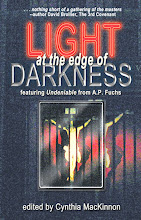
The Junkbots of Stéphane Halleux*
I’m a lifelong cyberpunk fan and those novelists who have influenced my own writing are the likes of Nyx Smith, Mel Odum, and Michael Stackpole. Of course, the gaming I’ve done over the years has informed my writing as well. Following last year's publication of FLASHPOINT: Book One of the Underground, I’ve just finished the second book of the Underground (War of Attrition, due for release sometime in 2009) and already have the outline of book three. Cyberpunk and its possibilities fascinate me, however, recently I’ve considered writing Steampunk or clockpunk.
Steampunk, for anyone unfamiliar with the genre, is essentially cyberpunk that takes place in the past and utilizes technology available at the time but not used to its potential—what an article at wired. com refers to as retro-futuristic. As the name indicates, the technological inventions use steam-power.** The punkish attitudes of the protaganists towards authority are evident in Steampunk while the stories are set in less-extreme dystopian societies (—though a trend has developed to set Steampunk in utopias).
Some well known examples of Steampunk: H.G. Wells’ The Time Machine, Jules Verne’s 20000 Leagues Under the Sea, William Gibson and Bruce Sterling’s The Difference Machine, Alan Moore’s The League of Extraordinary Gentlemen, and the Will Smith movie, The Wild Wild West (previously a tv series).
The whole premise of steampunk is fascinating—and certainly worth more research and consideration for a new novel or series.
* The Junkbots of Stéphane Halleux
The work of Belgian sculptor Stéphane Halleux gets described as "Tim Burton meets Jules Verne." Halleux uses lots of found objects and pieces of junk to create exquisitely detailed, surrealist mashups of organics and machinery that are simultaneously humorous, dark and filled with fairy-tale charm.
Steampunk, for anyone unfamiliar with the genre, is essentially cyberpunk that takes place in the past and utilizes technology available at the time but not used to its potential—what an article at wired. com refers to as retro-futuristic. As the name indicates, the technological inventions use steam-power.** The punkish attitudes of the protaganists towards authority are evident in Steampunk while the stories are set in less-extreme dystopian societies (—though a trend has developed to set Steampunk in utopias).
Some well known examples of Steampunk: H.G. Wells’ The Time Machine, Jules Verne’s 20000 Leagues Under the Sea, William Gibson and Bruce Sterling’s The Difference Machine, Alan Moore’s The League of Extraordinary Gentlemen, and the Will Smith movie, The Wild Wild West (previously a tv series).
The whole premise of steampunk is fascinating—and certainly worth more research and consideration for a new novel or series.
* The Junkbots of Stéphane Halleux
The work of Belgian sculptor Stéphane Halleux gets described as "Tim Burton meets Jules Verne." Halleux uses lots of found objects and pieces of junk to create exquisitely detailed, surrealist mashups of organics and machinery that are simultaneously humorous, dark and filled with fairy-tale charm.
**Although many people include inventions using clock mechanism within the SteamPunk subgenre, purists set it apart as ClockPunk.










4 comments:
Steam without Steampunk (Engine 2472 at the Speed of Light?)
For me, steampunk deals with the path not taken, with alternate history. In that world, technology is advanced and steam power widely used. Oh, for such a situation! Only in my dreams might Engine Number 2472 carry me at the speed of light.
I've working on a second age of steam novel and old locomotives have hooked me and my husband. Please use the link/address below to view the slide show of Engine Number 2472 taken over the Labor Day weekend. 2472 belongs to the Golden Gate Railroad Museum and is operated at the Niles Canyon Railway in California.
Laurel Anne Hill
www.laurelannehill.com
http://s301.photobucket.com/albums/nn45/Laurel_Anne_Hill/Engine%202472/?action=view¤t=8d07a719.pbr
Laurel--
Cool slide show.
You must have LOVED that train in Wild Wild West with Will Smith and Kevin Kline.
I agree--steampunk and clock punk are very much connected to alternate history in an Earth setting. Some would debate it's a sub-sub-sub genre. I just finished an article about spec-fic's sub-sub-genres where I've listed more of them than I can find anywhere on the Web. It will be featured in my next newsletter, then displayed at the lostgenreguild.com site.
Faith,
f
Coming, winter 2009
War of Attrition: Book Two of the Underground
Into the Underground: The Role-Playing Game
I've considered doing Steampunk (or Clockpunk--I'm not picky about nomenclature) for some time. The main problem I have with most people who write such things is that they don't truly understand the period, so they consistently misread the books, if they read them at all. But I'm familiar with Verne in particular, so I can write in that style quite easily.
When I was a kid in the 1970s, WGN, an Indie Chicago network, used to have a Sunday afternoon slot called Family Classics. My favorite of the old black and white films they'd run were 20k Leagues Under the Sea, Journey to the Center of the Earth, and Sinking of the Bismark. Born with spec-fic and action in my blood.
Faith,
f
Post a Comment